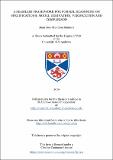Files in this item
A seamless framework for formal reasoning on specifications : model derivation, verification and comparison
Item metadata
| dc.contributor.advisor | Bowles, Juliana | |
| dc.contributor.author | Mendoza Santana, Juan Jose | |
| dc.coverage.spatial | viii, 311 p. | en_US |
| dc.date.accessioned | 2019-06-10T14:25:35Z | |
| dc.date.available | 2019-06-10T14:25:35Z | |
| dc.date.issued | 2019-06-26 | |
| dc.identifier.uri | https://hdl.handle.net/10023/17859 | |
| dc.description.abstract | While formal methods have been demonstrated to be favourable to the construction of reliable systems, they also present us with several limitations. Most of the efforts regarding formal reasoning are concerned with model correctness for critical systems, while other properties, including model validity, have seen little development, especially in the context of non-critical systems. We set to advance model validation by relating a software model with the corresponding requirements it is intended to capture. This requires us to express both requirements and models in a common formal language, which in turn will enable not only model validation, but also model generation and comparison. We present a novel framework (TOMM) that integrates the formalization of class diagrams and requirements, along with a set of formal theories to validate, infer, and compare class models. We introduce SpeCNL, a controlled domain independent subset of English sentences, and a document structure named ConSpec. The combination of both allows us to express and formalize functional requirements related to class models. Our formal framework is accompanied by a proof-of-concept tool that integrates language and image processing libraries, as well as formal methods, to aid the usage and evaluation of our theories. In addition, we provide an implementation that performs partial extraction of relevant information from the graphical representations of class diagrams. Though different approaches to model validation exist, they assume the existence of formal specifications for the model to be checked. In contrast, our approach has been shown to deal with informal specifications and seamlessly validate, generate and compare class models. | en_US |
| dc.language.iso | en | en_US |
| dc.publisher | University of St Andrews | |
| dc.rights | Attribution 4.0 International | * |
| dc.rights.uri | http://creativecommons.org/licenses/by/4.0/ | * |
| dc.subject | Formal models | en_US |
| dc.subject | Model validation | en_US |
| dc.subject | Model comparison | en_US |
| dc.subject | Model inference | en_US |
| dc.subject | Controlled Natural Language | en_US |
| dc.subject.lcc | QA76.9N38M4 | |
| dc.subject.lcsh | Natural language processing (Computer science) | en |
| dc.subject.lcsh | Computer software--Development | en |
| dc.subject.lcsh | Systems engineering | en |
| dc.subject.lcsh | Software engineering | en |
| dc.title | A seamless framework for formal reasoning on specifications : model derivation, verification and comparison | en_US |
| dc.type | Thesis | en_US |
| dc.contributor.sponsor | Consejo Nacional de Ciencia y Tecnología (CONACyT) (Mexico) | en_US |
| dc.contributor.sponsor | University of St Andrews. 7th century Scholarship | en_US |
| dc.type.qualificationlevel | Doctoral | en_US |
| dc.type.qualificationname | PhD Doctor of Philosophy | en_US |
| dc.publisher.institution | The University of St Andrews | en_US |
| dc.identifier.doi | https://doi.org/10.17630/10023-17859 |
The following licence files are associated with this item:
This item appears in the following Collection(s)
Except where otherwise noted within the work, this item's licence for re-use is described as Attribution 4.0 International
Items in the St Andrews Research Repository are protected by copyright, with all rights reserved, unless otherwise indicated.


